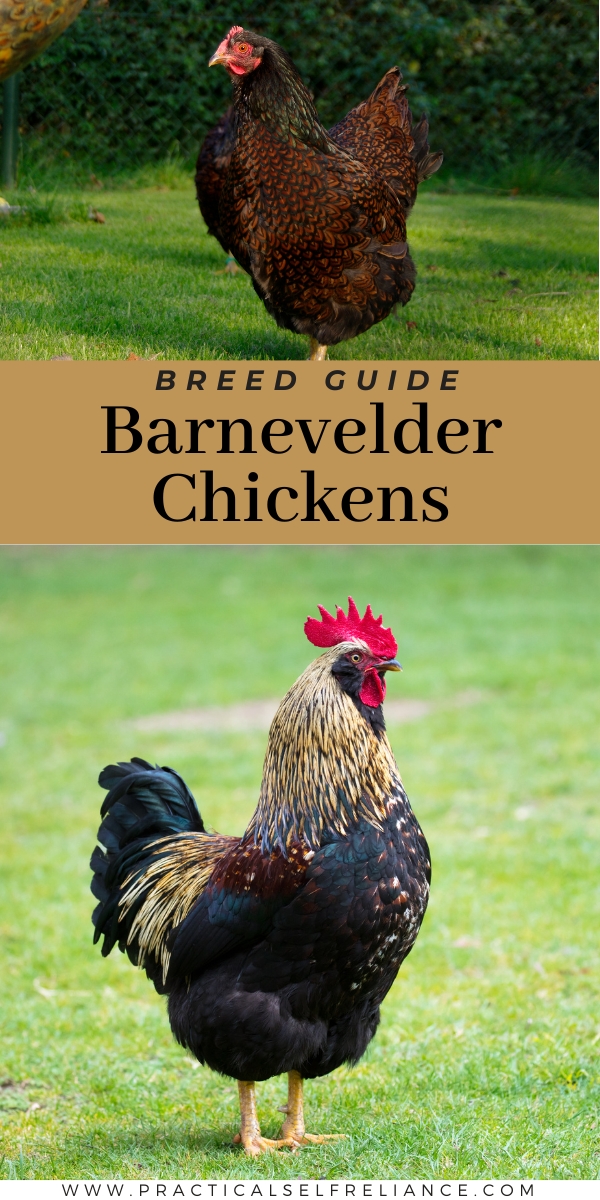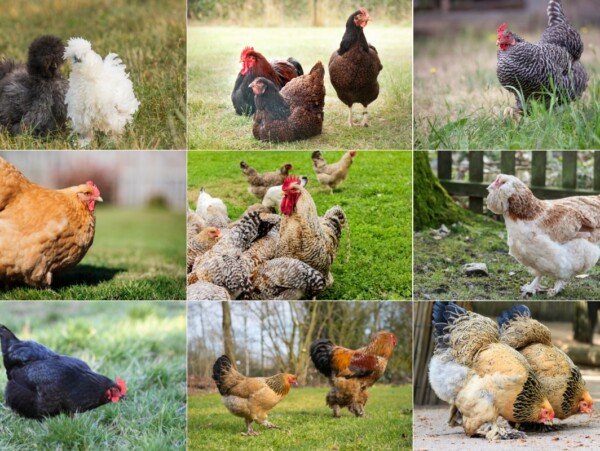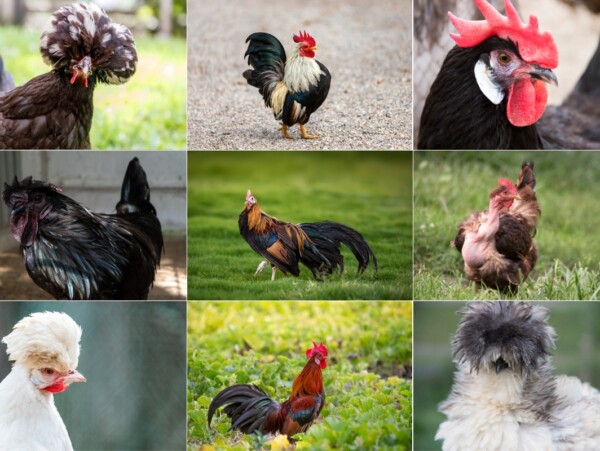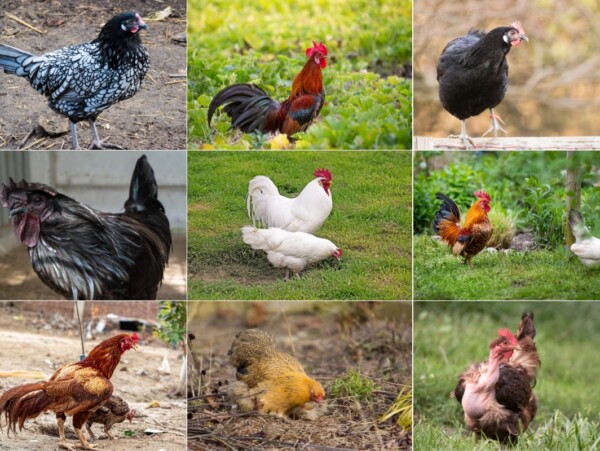Affiliate disclosure: This post may contain affiliate links. Please see our Privacy Policy.
Barnevelder chickens are becoming popular in backyard flocks for their striking dark brown eggs, beautiful plumage, and gentle, friendly disposition. They’re easy to raise, and perfect for beginning chicken keepers.

If you’re looking for a unique heritage chicken breed to add color to your egg basket, barnevelders are a great choice. They’re incredibly friendly and even-tempered, and their beauty rivals even the fanciest show birds.
Add in the fact that they’re cold-hardy, and you have a recipe for a spectacular backyard bird. Here are the pros and cons of the breed in a nutshell:
Pros
- Very gentle and easygoing
- Gets along well with other breeds
- Quiet
- Gorgeous showbirds
- Fine with confinement or free-range
- Winter eggs
- Cold hardy
- Good foragers
Cons
- Aren’t the most productive layers
- Aren’t the meatiest birds
- They may be picked on by more aggressive breeds
- Highly susceptible to Marek’s Disease
- Take longer than some other breeds to start producing eggs
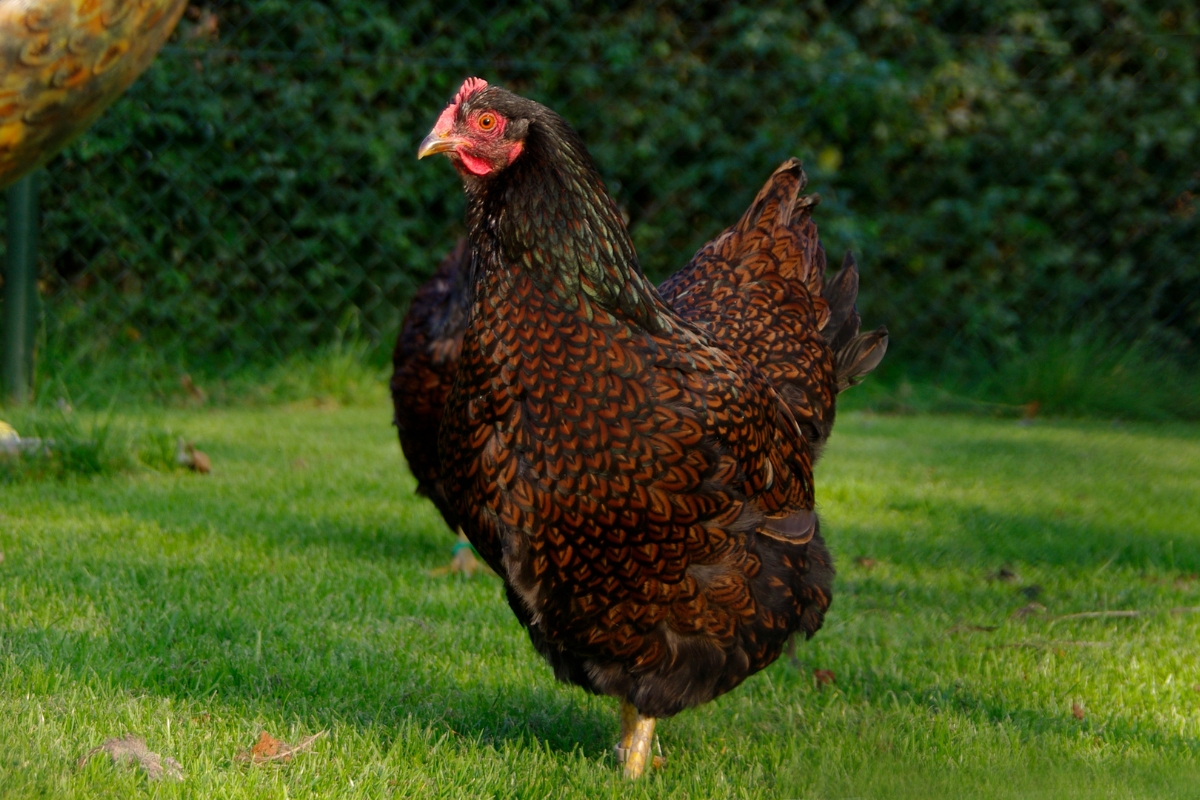
What are Barnevelder Chickens?
Barnevelders are a breed of chicken originally from the town of Barneveld in the Netherlands. These calm, friendly chickens are known for being reliable birds used for eggs and meat, and they are a great breed for novice owners.
Barneveld has a long history as a hub for poultry farming, and the municipality proudly claims to be the birthplace of the Barnevelder chicken. The lineage of the breed, though, isn’t completely clear.
In 1865, local Dutch chickens were cross-bred with chickens brought from Shanghai (like Cochins, Brahmas, and Langshans) to give them the ability to produce chocolate brown eggs, which were widely in demand across Europe at the time. These birds were potentially cross-bred with Amerikaanse Nuthoender chickens and golden-laced wyandottes later down the line.
Some poultry experts compared Barnevelders to “mongrel dogs” due to their lack of uniformity, and they came in all sorts of colors. In 1921, a breed standard for the Barnie was developed that centered around their appearance, but there is still a great amount of variation among the lineages of Barnevelder chickens.
Nowadays, Barnevelders are rare outside of Europe, but they are becoming more popular and can be found at most commercial hatcheries. They, like other heritage breeds, were phased out of the egg industry to accommodate more prolific layers. Despite this, there are many people that appreciate this lovely bird and what it adds to the flock.
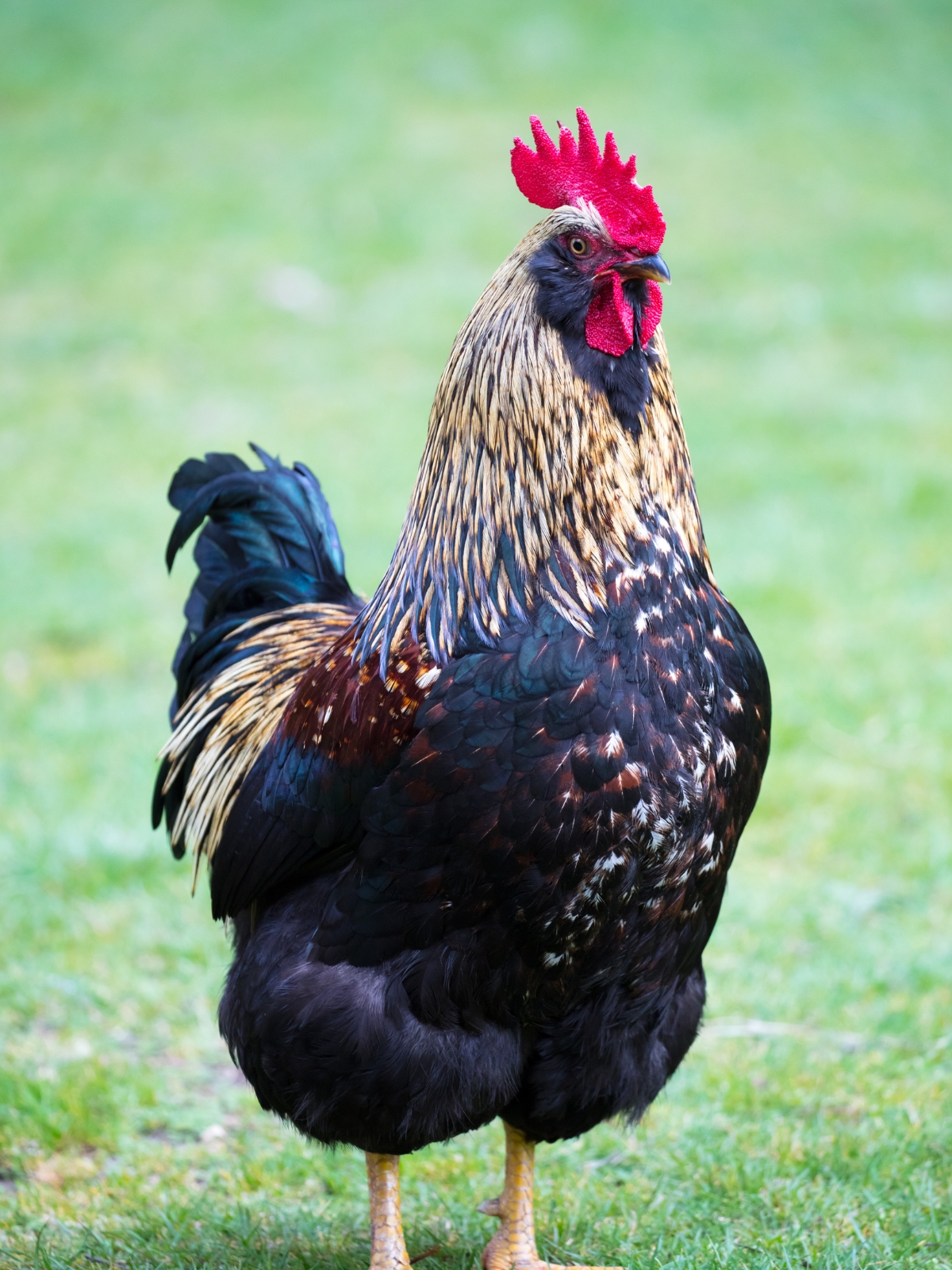
Barnevelder Chicken Characteristics
Barnevelders are a wonderful addition to your flock, as both their breathtaking beauty and gentle disposition make them great backyard chickens. While their feathers are vibrant and eye-catching, their demeanor and poise are graceful and understated.
As dual-purpose birds, Barnies are bred to produce both eggs and meat. They’re moderately good layers that will continue through the winter. Because they were bred to withstand harsh European winters, Barnies are cold-hardy. They are a medium-sized breed. Roosters weigh 7-8 lbs on average, and hens weigh 5-6 lbs.
- Breed Name: Barnevelder
- Breed Type: Standard for eggs, meat, and ornamental purposes
- Temperament: Calm, easygoing, and curious. Highly affectionate with their owners
- Size: Medium. Females are 5-6 lbs, and males are 7-8 lbs
- Eggs Per Year: 170-200
- Eggs per Week: 3-4
- Egg Size: Medium to large
- Egg Color: Various shades of brown
- Lifespan: Around 7 years
- Time To Maturity: 8-10 months
Barnevelder Breed Standard
It’s easy to appreciate the beauty of a Barnevelder. They come in a variety of colors and patterns, including white, black, silver-laced, blue double-laced, blue splash, golden-laced, brown-laced, and silver-black double-laced.
Due to their varied heritage, Barnevelders have different accepted breed standards in different countries. There are four colors that are recognized by the Dutch Barnevelder club, those being double-laced brown, double-laced blue, black, and white. On the other hand, in the UK, there are double-laced blue, double-laced brown, double-laced silver, and black. The American Poultry Association accepts double-laced chickens.
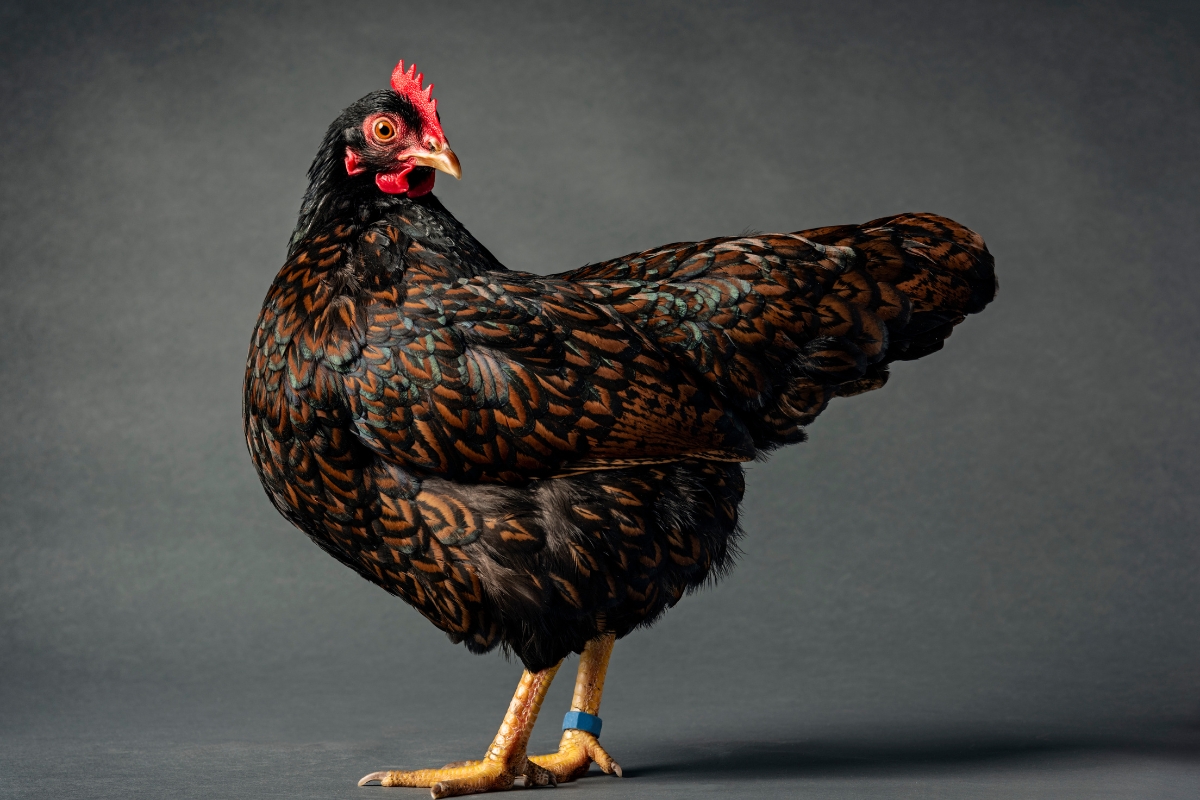
The most commonly accepted color variety across all countries is the double-laced brown, also known as chestnut. Chestnut roosters and hens are different but equally beautiful.
Hens are deep reddish-brown. Their feathers are framed with double black lacing over the wings, breast, back, and tail. Their heads are black with an iridescent green sheen. Roosters lack the double lacing on the chest that the hens have and instead have a simple, shiny black breast. Their tails are black with a beetle-green sheen.
Barnevelders have a very elegantly shaped body: they are compact and rectangular with a broad and deep back. Their necks are long, upright, and swoop gracefully. They have short wings for their size that are located high on their backs, making them poor fliers. Their legs and skin are bright yellow, and they have a single red comb.
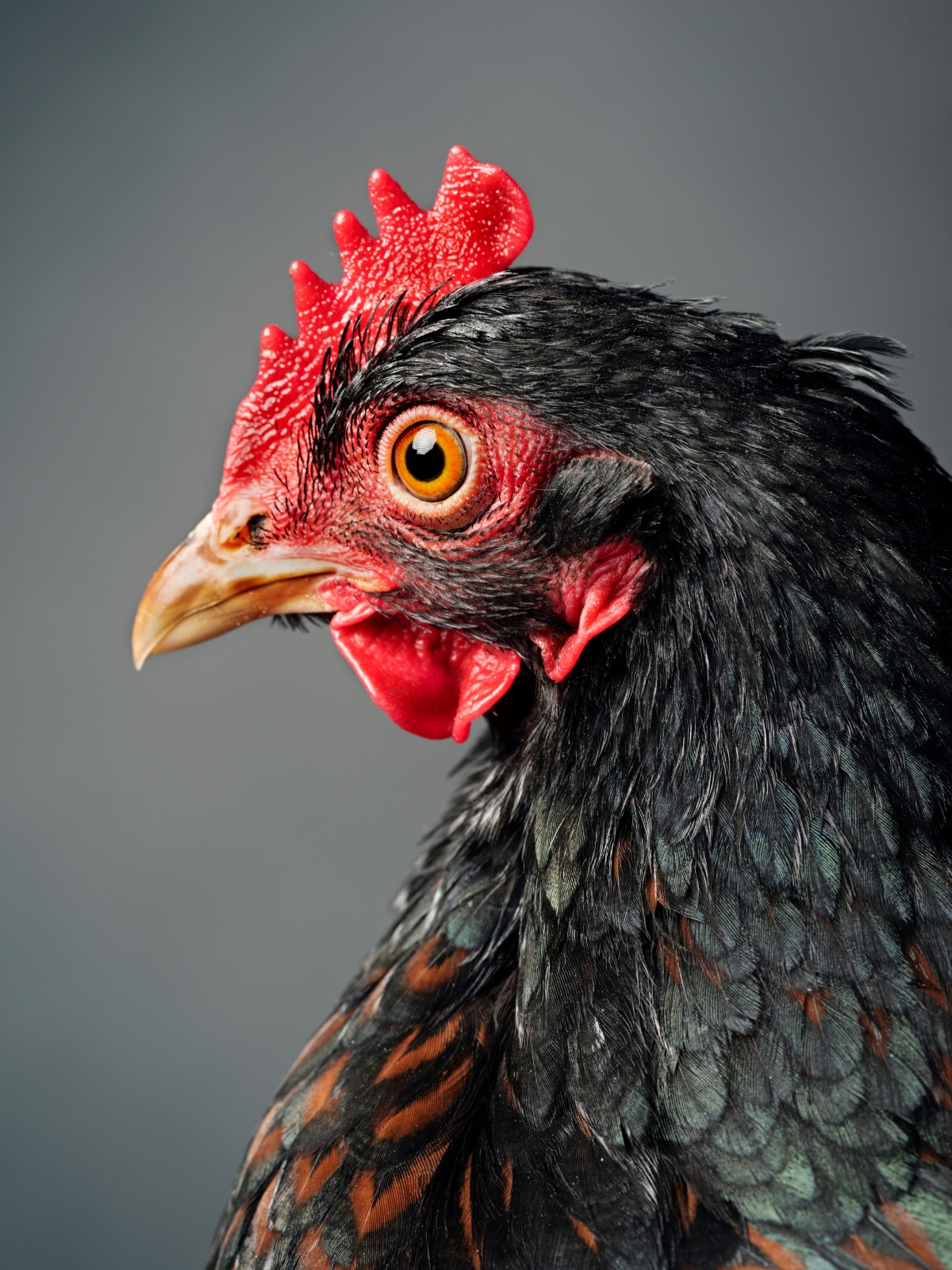
Temperament
Anyone that owns a Barnie knows that they are some of the sweetest chickens that you can have. They’re the first ones of the flock to greet you and ask you about your day. Despite being active and curious, Barnevelders are not loud, preferring to speak in hushed clucks rather than shouts.
These good-natured chickens are a great choice for first-time chicken owners or families with children. Besides their eggs and meat, it’s worth considering having a Barnevelder solely to be a companion because they’re so loving.
Barnies do well in both confinement and free-range. It’s recommended that they roam, though, since they love chasing after insects and digging in the grass. If you have a garden, your Barnies will make great pest control, slurping up grubs and picking bugs off of your plants.
Because of their easygoing nature, Barnevelders rarely cause squabbles in the flock. Even the roosters are known for being quiet and gentle. They don’t bully other breeds, but due to their personality, they might be picked on by more aggressive chickens.
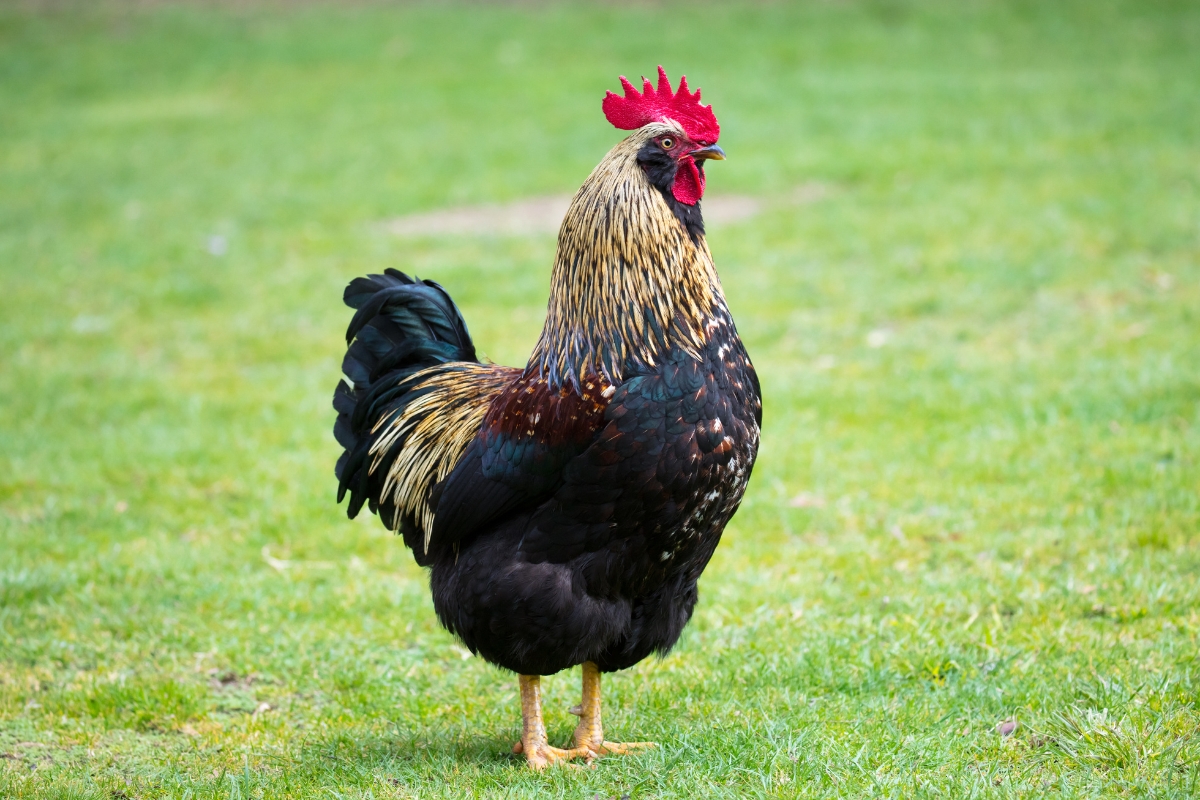
Hardiness
Barnevelders were bred to endure the harsh winters in the Netherlands and are very tolerant of cold, damp conditions. While Barnies aren’t troubled by the cold, it’s still important for your flock to have proper shelter from extreme weather.
Barnevelders are also fairly tolerant towards heat, but, like most other chickens don’t do well in high humidity. Again, it’s important to make sure your birds have a safe, comfortable place to stay that has sufficient shade and water.
Egg Production
While they aren’t the most productive breed, Barnevelders are reliable egg layers. They lay 3-4 eggs per week. Because they’re dual-purpose chickens, Barnies start laying eggs later in life than other breeds, at 8-10 months instead of 6. While they start late, they also continue to lay later in life.
Egg Color
Early Barnevelder breeders prioritized egg color– they sought chickens that produced eggs of a deep chocolate brown. Later, breeders prioritized the color of the chicken’s plumage and paid less attention to egg color, resulting in a lot of irregularity.
Barnevelders lay brown eggs, but they vary a lot in shades– they range from light to dark brown, and some are speckled. If you’re looking for the signature chocolate brown egg, it’s best to contact a breeder that’s focused specifically on that trait.
Meat
Barnevelders aren’t the biggest bird but produce a reasonably large carcass. Again, finding a breeder that’s prioritized meat in their chickens’ bloodline will help if you’re breeding Barnies to eat.
Broodiness
There is a lot of variability in the broodiness of Barnevelder hens. Some people report that their hens are very broody, while others never go broody. Generally, Barnevelders are great caregivers to their chicks and pay close attention to them.
Foraging Ability
There’s nothing a Barnevelder loves more than foraging. These birds will chase every insect that they see. They’ll lower your feed bill in that way, but also might cost a bit of lawn work– they like tearing up grass.
Cross Breeds
There has been plenty of cross-breeding within Barnevelder bloodlines, so much that it’s hard to find a breed standard. After chickens brought from Asia were bred with the local chickens in Barneveld, some lines might have crossed with Amerikaanse Nuthoenders (a similar breed to American Wyandotte) and British Buff Orpingtons. Some breeders crossed Barnevelders with Marans to try to get them to produce chocolate brown eggs, which was lost when their plumage standardization was prioritized, but these chickens then lost their plumage. Barnies have a complicated family history.
Common Health Issues
Because of the cross-breeding done to Barnevelders to create their beautiful black-laced plumage, they are very susceptible to Marek’s Disease.
Marek’s Disease is also called “fowl paralysis” and is a highly contagious form of Herpesvirus that results in inflammation of the nervous system, tumor growth, and paralysis.
Luckily, MD is preventable, as long as chickens are vaccinated against the disease before it is exposed to the flock.
Barnevelder Chicken FAQs
Hopefully, I’ve told you everything you need to know about adding a Barnie to your flock. Here are some common questions about Barnevelders that might help you decide whether they are right for you.
Are Barnevelder chickens friendly?
Yes, Barnevelders are a docile, friendly breed. They are talkative, but not loud, making them good for keeping peace with your neighbors. They’re great chickens for families with kids due to their affectionate, gentle nature.
Are Barnevelder chickens good egg layers?
Barnevelder chickens are good egg layers, averaging 3-4 eggs per week.
What color egg does a Barnevelder lay?
Brown. Their eggs range in color from pale brown to dark chocolate, sometimes with speckles. They were bred to produce dark brown eggs, which were popular in Europe when they were developed, but lighter shades are also possible.
Are Barnevelder hens broody?
Some Barnevelder hens can be broody, but it ultimately depends on their lineage– some people report that their hens aren’t broody at all.
How big are Barnevelder chickens?
Barnevelder chickens are medium-sized. Roosters weigh between 7-8 lbs, and hens weigh 5-6 lbs.
Are Barnevelder chickens good for meat?
Yes. Their medium-sized carcass yields a fair amount of meat.
Are Barnevelder chickens autosexing?
Autosexing is used to refer to breeds of chicken that have different-looking male and female chicks. Autosexing Barnevelders exist in Europe but are not found in other parts of the world. The sexes can be distinguished reliably after about 12 weeks, but there are no notable differences between female and male chicks.
Are Barnevelder chickens cold-hardy?
Yes, Barnevelders are cold-hardy. They were specifically bred to survive harsh winters in the Netherlands, and they lay well into the winter when other chickens have stopped laying.
How long do Barnevelder chickens live?
The average lifespan is seven years, although they may live longer in the right conditions. Barnevelder hens start laying at around eight to ten months, which is a bit later than other breeds, but are productive for longer.
Are Barnevelder chickens easy to raise?
Yes. Barnevelders are known for being easy chickens to handle, even for new owners. They thrive in both free-range and coop conditions. They are excellent foragers and will happily clear your garden of grubs.
